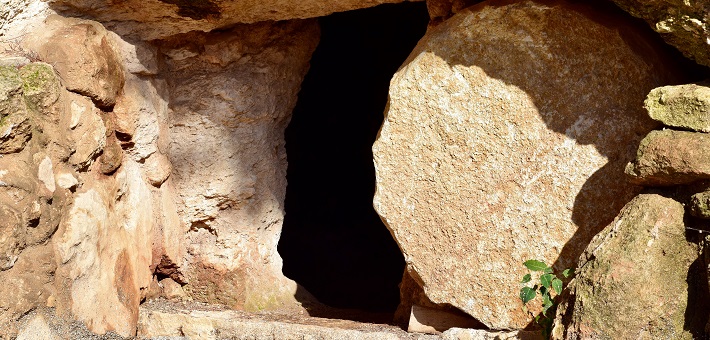Commentary on John 20:1-18
We have seen so many tombs—and countless deaths that could not even have proper tombs— since the outbreak of COVID-19.
There has been so much grieving and weeping over innumerable losses. The pandemic brutally took our loved ones. We are afraid of our own potential deaths. Might the author of John’s Gospel have seen a similar reality for “death-bound subjects” in his time?
I cannot understand the tomb
The word “tomb” appears most frequently in the Gospel of John among all the Gospels, particularly in this chapter. Also, both forms of the verb “die” (apothnēskei and thnēskei) are present more times in John than the total appearances of these words in the Synoptic Gospels.
This Resurrection Sunday we visit the tomb of Jesus when it is still dark, just like Mary Magdalene (John 20:1). She sees the stone removed from the tomb. The message she delivers to Peter and the other disciple whom Jesus loved is about the missing body. John’s resurrection story is not triumphant but instead leads us to look into the reality of death, where we unexpectedly but intimately encounter the risen Jesus.
John painstakingly describes how Jesus’ disciples—male and female—cope with his death and absence and come to believe in his resurrection. Another word John most often uses is the word idein translated as “see,” “know,” or “understand.” Mary Magdalene went to Peter and the other disciple, saying that “we do not know where they have laid him” (20:2; see also verse 13). The two disciples appear to compete to get to the tomb first, go inside the tomb one by one, and see nothing inside but the strips of linen and the cloth that had been wrapped around Jesus’ head (20:3-8: see also 11:44).
The beloved disciple seems exceptional because “he saw and believed,” but the following narration seems to contradict this because he is one of those who do not yet “understand the scripture, that Jesus must rise from the dead” (20:8-9). If he believed that Jesus has risen, he would have announced to the others just as Mary does (verse 18). Although they are supposed to recognize Jesus, remember his words, and understand the scripture (2:22; 12:16), this is not the case for the disciples yet. They return (aplēthon) to their homes “again” so quickly (20:10; see also 16:32). Did they not all step back (aplēthon) when their teacher was arrested in the garden (18:6)? After seeing the empty tomb, fear possesses them so that the disciples go to lock themselves in a house at the evening of the day (20:19).
The flesh dwelling among us
However, Mary still remains outside the tomb and weeps (20:11). Only at this time does she look inside and see two angels sitting where the body of Jesus was lying. The word here for “body” (sōma) is used exclusively to illustrate the dead body in John 19-20 (see also 2:21). When the angels ask, “Woman, why are you weeping?” her answers are the same as the words she spoke to Peter and the beloved disciple: “They have taken away my Lord, and I do not know where they have laid him” (20:13). Then, Jesus appears to her, but again, she does not know that it is Jesus (verse 14). This time Jesus asks, “Woman, why are you weeping? Whom are you looking for?” (verse 15). When the latter question was asked to armed soldiers that came to catch him in the garden, it portended betrayal and denial (18:4, 7, 26), yet here the question the risen Jesus asks Mary in the garden is affectionate (see also 19:41). She desires to take away the dead body of her loved one.
There is another word that points to Jesus’ embodiment. It is “flesh” (sarx). From the outset, John declares, “The Word became flesh and made his dwelling among us” (1:14). Jesus identifies his flesh as the bread that I will “give for the life of the world” (6:51). Resurrected, he still has the marks of violent death (20:17). He knows the brutal force of death, as well as human frailty with its decaying flesh. Thus, Jesus in his earthly life wept with Mary of Bethany, as she grieved the death of her brother Lazarus (11:31-32). Now the risen Jesus sees Mary Magdalene weeping. He calls her by name, “Mary.” Only at this moment can she recognize her teacher and friend, Jesus.
Longing for intimate encounter
We are not certain what bodily form Jesus has, as he is risen but not ascended yet. What we can know is that Mary wants to touch him. She is not allowed to do so but instead is commissioned to go to the disciples whom Jesus calls “my brothers (and sisters).” Jesus says to her that he is ascending to his Father who is “your Father.” “My God is your God” (verse 17). The son is close to the Parent’s bosom (1:18), and this intimate relationship is extended to the relationship between the loving Parent, Jesus, and his friends. The Parent will love anyone who loves Jesus, and they will “make home” there (14:2, 23). Instead of the Father-Son language, we may focus on this post-resurrection story full of imagery of intimacy, as well as the role of the woman who became the first witness to the resurrection as Mary Magdalene announces to the disciples, “I have seen the Lord.”
When it is still dark, we declare, “The light shines in the darkness, and the darkness did not overcome it” (1:5). In our darkest days, we still see a glimpse of light. We often do not see Jesus standing in our midst (20:14, 19, 26; see also 21:4). On this Resurrection Sunday, it is okay that we still mourn. Yet the risen Christ is standing there, showing that death is not the final word but God’s love embraces the living and the dead. The intimate presence of the wounded Christ is our comfort.


April 4, 2021